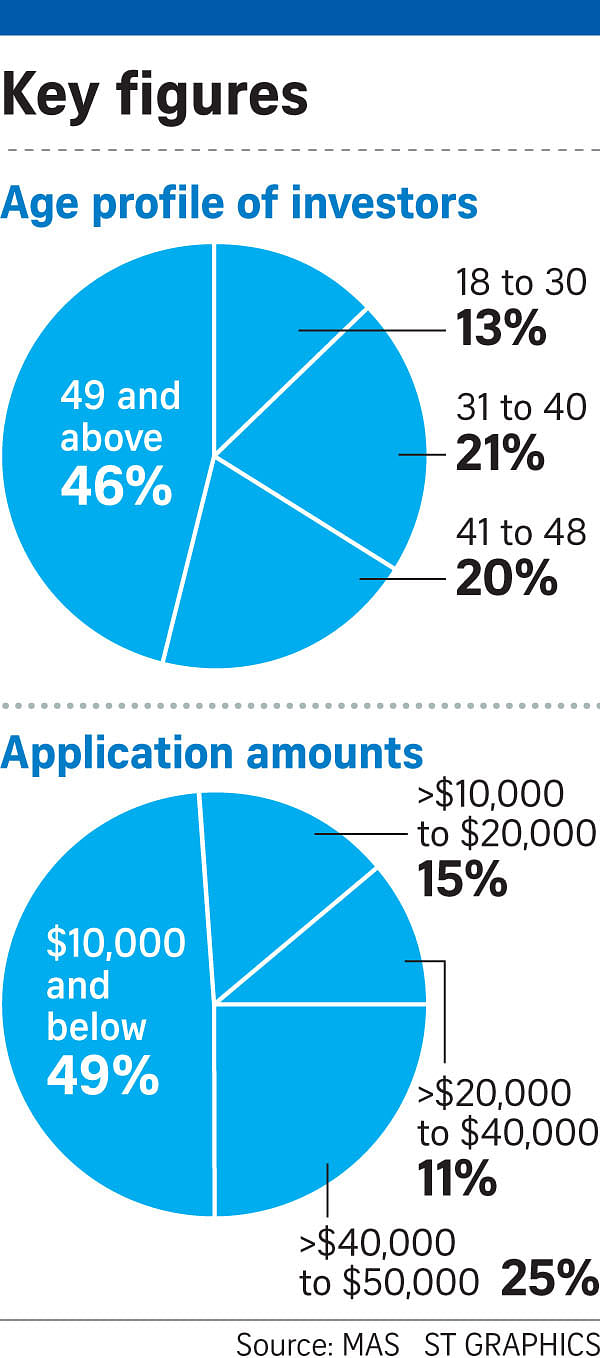The number of investors buying risk-free Singapore Savings Bonds (SSB) over the past six months has shot up - and a significant number are first-time buyers of securities.
About 32,000 people had invested $810 million in SSBs as at March 1. That was almost double the $413.16 million from about 19,500 applicants at its launch in September. Since then, there have been six SSB issues - one every month.
The lion's share of investment comes from those who are aged 49 and above, accounting for almost half or 46 per cent of all investors.
Nearly two out of 10 were new Central Depository (CDP) account holders, suggesting SSBs were their first foray into securities.
The Monetary Authority of Singapore (MAS) was providing updated information on SSBs yesterday.

The total investment amount received so far is way below the maximum $4 billion available this year.
Despite this, MAS emphasised SSBs have significantly boosted retail investors' participation in the Singapore Government bond market.
Only about 2,000 retail investors hold a total of $300 million of conventional Singapore Government Securities (SGS), which means about 16 times as many have put their money into SSBs.
SSBs are targeted at retail investors who want higher interest than bank deposits but are leery of putting their savings at risk.
By setting the minimum application amount at $500, SSBs are available to even investors with only small sums to invest. Indeed, MAS noted that half or 49 per cent of all applications are for sums that were $10,000 and below.
A significant 13 per cent were young investors aged 18 to 30.
MAS said that these are encouraging developments as SSBs are intended to be a safe, flexible and long-term instrument that are suitable for new investors.
MAS said: "As they become more familiar with investing, these first-time investors could consider other instruments for long-term investment, including equities, bonds, exchange traded funds and unit trusts.
"We also hope to promote greater awareness of the Savings Bond and its features among investors saving towards retirement or who are retiring. The safety and flexibility of SSBs mean that they can form part of an investor's portfolio to complement equities and bonds."
To raise awareness of SSBs, the national financial education programme MoneySense has held numerous seminars and roadshows to reach out to retail investors.
Mr Vincent Tey, director, advisory, of wealth management firm Providend, said that it is not surprising to find older investors investing in SSBs as they would typically prefer lower-risk investments.
In line with the declining average 10-year SGS yields, the SSBs' average annual interest rates across the past six issues have generally fallen.
The average interest rate of the first six issues was 2.63 per cent, 2.78 per cent, 2.44 per cent, 2.5 per cent, 2.58 per cent and 2.09 per cent.
SingCapital chief executive Alfred Chia noted that the SSBs were launched when banks were offering attractive promotional interest rates on fixed deposits and that could have further dampened the demand for SSBs. Other factors include the lack of awareness and the need to open a CDP account.


